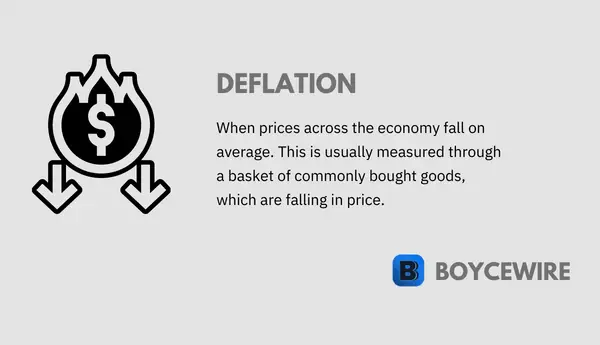Deflation: Definition, Causes & Effects

What is Deflation
Deflation occurs when the prices of goods and services start to decline throughout the economy. It is generally associated with a contraction in the money supply. This is where the total amount of money in the economy starts to represent fewer number of goods. One of the leading causes is where economic growth outpaces the supply of money to the economy.
Deflation can be good in the short-term as it can boost disposable income and increase demand. However, in the long-term, if consumers start to expect deflation year on year, they start to push purchasing decisions back in the hope they will get the product even cheaper next year. We then see permanent deflation which can depress economic output.
Key Points
- Deflation occurs when prices in the economy are declining.
- If deflation is persistent, it can create a drag on the economy as consumers push back spending as goods will become cheaper year on year.
- Some causes of inflation include: supply shocks, falling consumer demand, increased productivity, technological advancement, and the money supply.
Types of Deflation
Macro Level Deflation
There are two main types of deflation. First of all, there is macro level deflation. So how average prices across the nation are being affected. Deflation could occur on a macro level if average prices are in decline.
For example, prices of iPhones may go up, but if prices of everything else are declining, we see deflation on a macro level. To put it another way; macro deflation refers to prices falling on average across all the goods and services in the economy.
Micro Level Deflation
Second of all, we can look at deflation on a micro level. In other words, how the prices of a specific good are being affected. So the price of an iPhone may start to decline, thereby creating deflation. To put it another way; micro deflation refers to prices falling on a specific product rather than everything made in the economy.
Causes of Deflation
There are a number of factors that can cause deflation. Yet it should be noted that these factors alone may not necessarily cause deflation. For example, a decline in demand for goods may cause businesses to reduce prices to stimulate demand. We would therefore expect deflation. Yet if the central bank is printing billions in currency, this deflationary pressure could be offset as this currency enters the economy creating an inflationary effect.
Therefore when we look at the causes of deflation, they are factors that can contribute to deflation when looked at in isolation. In other words when no other variables are at play. Yet in reality, they all come together to create deflationary pressures in their own right.
1. Fall in Consumer Demand
When consumers demand less of a product or service, it sends a signal to the producer. When demand falls, it sends a signal that the price is too high, or the product is of insufficient quality. This can happen quite rapidly, so a business may suddenly experience a drop in demand for their product year on year.
What this does is encourage the business to reduce the amount of staff they have, reduce prices, or improve its products. Some will get rid of staff, whilst others will reduce prices. However, one businesses employee is another’s consumer. So once that employee is let go, demand falls further.
In turn, initial levels of deflation can cause a vicious cycle. Businesses cut jobs, thereby reducing demand and incentivising further job cuts. So as unemployment goes up and businesses see further declines in demand, they have no choice but to reduce prices and/or cut costs.
2. Aggressive Competitive Markets
Another cause of deflation can be seen as a result of aggressive competition. On occasion, markets can become extremely competitive. Perhaps the industry is ageing and struggling to attract new customers, so existing players cut prices. Or, alternatively, the industry is new and growing so new and existing firms cut prices to attract consumers in a growing market.
For example, in recent years, the US’ mobile phone operators AT&T, T-Mobile, and Verizon, all introduced a number of price cuts to their mobile tariffs. The price war between the companies started in 2016 and continued in subsequent years. In 2019, AT&T extended its price cuts and reduce prices by about $5 per line, which immediately put Verizons planned $10 price increase on hold.
The price war between the telecoms giants has proven to be deflationary in terms of prices. So on a micro-scale, it has led to deflation within the sector. At the same time, it highlights the fact that mature markets often tend to create a deflationary environment as overall growth starts to stall.
For instance, the number of customers without a wireless internet connection is almost non-existent. AT&T, T-Mobile, and Verizon are therefore limited in the amount of growth they can achieve, thereby relying on picking off existing customers from each other at lower prices.
3. Increased Productivity
When productivity increases, it means firms require fewer inputs to make the same number of outputs. In other words, it doesn’t take so much time, effort, or money to make the same number of goods. Production is therefore more efficient.
As a result of productivity gains, businesses don’t need to spend as much to bring the good to the consumer. So in a competitive market, they will start to reduce prices in order to compete for customers. As businesses compete for customers, prices start to decline which causes deflation. However, this may a short-term adjustment to reflect the new productivity gains.
If Business A buys a new machine that produces two times as many goods, it may be able to reduce prices by roughly half. So the business may be able to reduce prices permanently, but they won’t continue to decline unless further productivity gains are made. Therefore, whilst productivity gains may contribute to deflation, these may only be for the short-term.
4. Technological Advancement
Another cause of deflation is that of technological decline. Each year the latest iPhone comes out and in the subsequent years, it loses value as newer and more powerful models come out. What we see as a result is a gradual deflation in the price of the original device as the technology becomes obsolete.
We see this everywhere in technology. From TV’s to mobile phones, to laptops. As newer technology comes out, it reduces the value of what came before. So over time, older models deflate in price. If we look at the first-ever mobile phone, the Motorola 8000X, it cost $3,995 back in 1983. Yet we can buy a new smartphone for less than $500 today and with far more features than the Motorola 8000X.
5. Supply Shocks (Oil)
Historic supply shocks, particularly that of oil can contribute significantly to deflation, at least on a short-term basis. For example, in 2015, the price of crude oil fell from over $100 in late 2014, to $40 by the end of the year.
This was driven by an increased level of supply, particularly the new innovation of fracking in the US. As a result, prices came down, playing a crucial part in suppressing the overall rate of deflation.
However, the impact oil has on developed economies such as the US has been deteriorating over time. Such economies are moving more towards service-based markets that rely less on manufacturing and fossil fuels. At the same time, there has been an increased focus on creating renewable energies and thereby reducing reliance on unsustainable fossil fuels. Therefore, in years to come, oil supply shocks are likely to have a less significant impact going forward.
6. Money Supply
In the aftermath of the 1929 Great Recession, prices fell by over 25 percent across the subsequent three years. What happened was the US economy was growing, with more and more goods being produced each year. However, the Federal Reserve failed to produce enough dollars to represent those new goods that were now being made.
To explain, let’s look at Country A. It makes 100 oranges with $100 in circulation. So each orange represents $1. However, due to economic advances, it now makes 150 oranges. Yet the central bank has failed to created more money to account for the increase in production. In turn, the 150 oranges represent $100 and therefore amount it $0.66 each. A significant level of deflation.
Therefore, when the money supply does not increase at the same level of economic output, we can see significant levels of deflation. At the same time, too much money added can have the opposite effect and create hyperinflation.
7. Consumer Expectations
If consumers are uncertain about their future income and the overall economy, they may push purchasing decisions backwards. In other words, they will start to save more and consume later. This may because there is an overall uncertainty about job security. As a result, businesses face a reduction in demand and will therefore start to reduce prices to attract consumers.
If deflation kicks in before consumers’ expectations change, it can prove to be a vicious cycle. Deflation starts as businesses reduce prices, but consumers will continue to push back purchasing decisions in the expectation that prices will fall further.
Effects of Deflation
In this part, we will look at how macro-level deflation effects the economy. In other words, when the majority of goods in the economy start to fall in price. This is opposed to micro deflation where the price of your coffee falls by 5 percent, but everything else is still increasing in price.
1. Declining Demand
Perhaps one of the most prominent effects of deflation is declining demand. When prices fall across the economy, it sends a signal to consumers. In the short-term, the economy may benefit as consumers see falling prices and buy more. This increase in demand may then stimulate further business investment and production.
The wider economy can benefit from temporary deflation as it can stimulate demand. However, if the money supply does not increase alongside economic output, deflation can become permanent. In other words, if deflation stimulates greater production, but the amount of money in circulation stays the same, there are more goods being produced, but not enough money to maintain its value.
In such a situation, deflation can become permanent and self-fulfilling. This is because consumers start to expect falling prices and therefore push purchasing decisions back. Furthermore, when deflation sets it, the value of $1 will be greater in the future. So it pays to keep hold of money, even if it’s under the bed.
2. Unemployment and Lower Wages
As businesses see lower levels of demand, they also see lower profits and a reduced need for workers. They simply do not need as many workers as they aren’t selling as much as before. Consequently, businesses start getting rid of excess employees they no longer need.
Alternatively, some businesses may look to lower wages instead as it can be extremely expensive to lay off workers in some countries. So businesses cut prices, but they also cut workers’ wages and potentially make some redundant.
This has a more far-reaching effect as those made unemployed are also more likely to default on their debt or fail to repay it. Consequently, banks tend to lose money during such periods. They then tend to try and reduce their exposure to risk by increasing the amount of cash on hand as well as reducing the number of loans they issue.
3. Debt Burden Grows
As deflation takes hold, prices and incomes decline. Businesses are taking in less money than before and employees are taking in less as well. So when a business or consumer takes out a loan, they have to repay that amount back. Yet their incomes are declining, meaning it takes them longer to take it back.
For example, Mr A takes out a loan for $100,000 and earns $50,000 a year after tax. So that works out at roughly 2 times his annual salary. The next year, he still owes $100,000, but due to deflation, he is now only receiving $45,000, which works out at just over 2.2 times his annual salary.
If deflation continues, the situation will continuously worsen until the debt burden becomes unsustainable. For instance, a mortgage payment of $1,000 a month isn’t going to change, but the amount on income coming in will.
4. Reduced Investment
As prices decline, both consumer products and capital equipment fall in price. That means businesses looking to invest face the same choice as consumers. Pay more now, or wait till next year and pay a lower price. As a result, both businesses and consumers invest and spend less.
At the same time, business are also faced with an increasing debt burden. This is because deflation is forcing them to reduce its prices and profits, but the amount it owes remains the same. Consequently, businesses are having to use more of their profits to pay off their debt. Therefore, businesses have to pay more for their debt, thereby disincentivizing them to take out further loans in the future.
5. Strengthening Currency
As deflation pushes prices down, it means international firms can buy more for less. For instance, the UK may be experiencing deflation which means that £1 of goods is now worth £0.90. As a result, foreign importers need less currency in order to buy the same amount of goods.
In turn, more goods are demanded from abroad, boosting UK exports, and increasing demand for the Great British Pound. With that, the Great British Pound starts to strengthen in value to bring prices back into equilibrium. In other words, foreign importers can no longer buy UK goods at cheaper prices.
FAQs on Deflation
Deflation is not bad as such – it can provide a boost to economic growth if consumers believe prices won’t continue to fall. In other words, consumers will increase spending if they see prices fall, but expect them to rise again in the future. However, deflation can be bad if consumers start to expect it – which can lead to delayed consumption and therefore lower economic growth.
In economics, deflation occurs when average prices across the country fall as measured by the Consumer Price Index (CPI).
In the short-term, deflation may reduce unemployment if it incentivises consumers to go out and spend their money on goods that are seeing a reduction in price. If it increases demand in the economy, then it has the potential to create jobs.
About Paul
Paul Boyce is an economics editor with over 10 years experience in the industry. Currently working as a consultant within the financial services sector, Paul is the CEO and chief editor of BoyceWire. He has written publications for FEE, the Mises Institute, and many others.

Further Reading
 Net Income: Definition, Formula & Example - Net income (NI) is the amount of income an individual or business receives, minus any expenses.
Net Income: Definition, Formula & Example - Net income (NI) is the amount of income an individual or business receives, minus any expenses.  Availability Heuristic: Definition & Examples - The availability heuristic is where recent memories are weighted more significantly.
Availability Heuristic: Definition & Examples - The availability heuristic is where recent memories are weighted more significantly.  Trade Deficit: Definition, Causes & Effects - A trade deficit occurs when a nation imports more goods than it exports. In other words, a nation buys more…
Trade Deficit: Definition, Causes & Effects - A trade deficit occurs when a nation imports more goods than it exports. In other words, a nation buys more… 